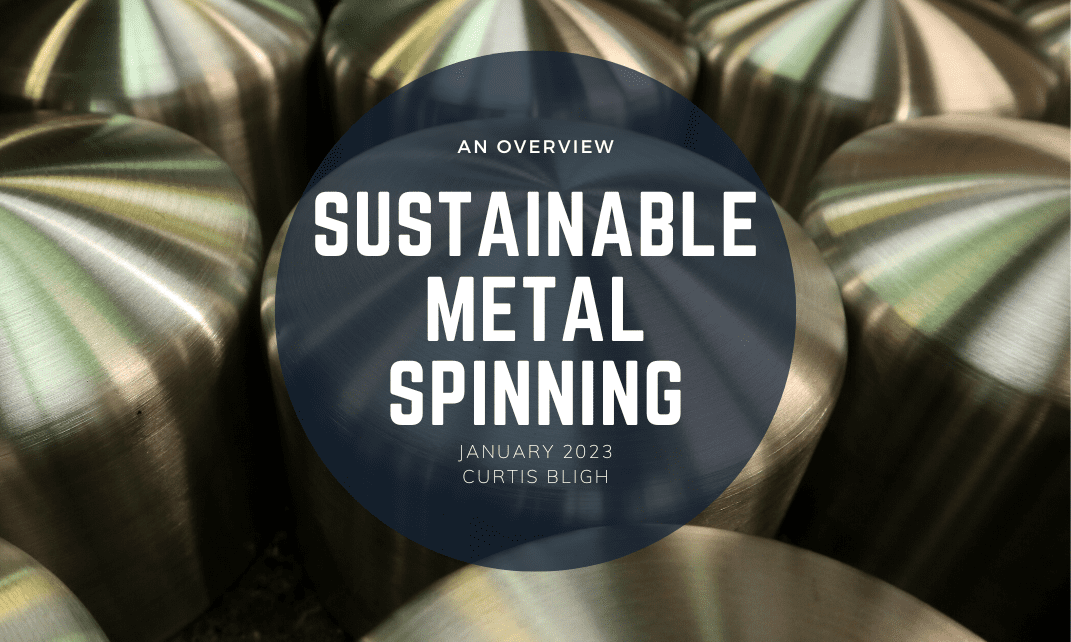Sustainable Metal Spinning: An overview

Curtis Bligh
- 4 Min Read
1. Introduction to Metal Spinning and its Benefits
Metal spinning, also known as spin forming or spinning, is a metalworking process in which a piece of sheet metal is formed into a desired shape using a rotating tool called a mandrel. This process is used to create a variety of products, including pots and pans, automotive parts, and decorative metalwork. You can learn more about Metal Spinning by reading “What is the Metal Spinning Process?
One of the primary advantages of metal spinning is that it allows manufacturers to create complex, precise shapes using relatively simple equipment. This makes it an economical option for producing small to medium batches of products. In addition, metal spinning generates very little waste, as the excess material can be recycled or reused.
However, there are also some concerns about the sustainability of metal spinning. One issue is the energy consumption of the process. Metal spinning typically requires a significant amount of energy, and in some circumstances the metal must be heated to high temperatures in order to be pliable enough to be shaped. This energy consumption can have negative environmental impacts, particularly if it is generated from non-renewable sources such as fossil fuels.
2. Strategies for improving sustainability of Metal Spinning
To mitigate the energy consumption of metal spinning, manufacturers can adopt energy-efficient technologies and practices. For example, they can invest in advanced heating systems that use less energy or switch to renewable energy sources such as solar or wind power. They can also implement energy-saving measures such as turning off equipment when it is not in use and using insulation to reduce heat loss.
Another potential sustainability concern with metal spinning is the use of toxic chemicals. Some metal finishing processes, such as electroplating, involve the use of hazardous chemicals that can have negative impacts on the environment if not handled properly. To address this issue, manufacturers can adopt eco-friendly alternatives to these chemicals or implement strict safety protocols to prevent accidental releases.
In addition to the environmental impacts of metal spinning, there are also social and economic sustainability considerations. Metal spinning is a labour-intensive process, and it is important for manufacturers to provide fair wages and safe working conditions for their employees. This not only benefits the workers themselves, but it can also contribute to the overall sustainability of the company by reducing turnover and improving productivity.
3. Certification and Stakeholder engagement for sustainable Metal Spinning
To ensure the long-term sustainability of metal spinning, it is important for manufacturers to adopt a holistic approach that considers the environmental, social, and economic impacts of the process. This can involve implementing sustainable practices and technologies, as well as engaging with stakeholders such as customers, employees, and local communities.
One way for manufacturers to demonstrate their commitment to sustainability is by obtaining certification from a recognized organization. For example, the ISO 14001 standard is a widely recognized certification for environmental management systems, and the ISO 9001 standard is a certification for quality management systems. By obtaining these certifications, manufacturers can demonstrate to customers and other stakeholders that they are taking steps to minimize their environmental footprint and ensure the quality of their products.
4. Conclusion
In conclusion, metal spinning is a valuable manufacturing process that has many advantages, including its ability to create complex, precise shapes with relatively simple equipment and its low level of waste. However, there are also some sustainability concerns that need to be addressed, including energy consumption and the use of toxic chemicals. By adopting sustainable practices and technologies and engaging with stakeholders, manufacturers can ensure the long-term sustainability of metal spinning.
Related Articles

Boosting British Manufacturing: A £360 Million Investment
Boosting British Manufacturing: A £360 Million Investment Facebook Twitter LinkedIn WhatsApp Email It’s been declared ahead of the Budget that Chancellor Jeremy Hunt will announce

Design Considerations for Metal Spinning Success: Part One
There are many design considerations businesses should considers to get the most out of their metal spinning supply. Read Part One here

The Importance of Innovation in UK Manufacturing
Manufacturing plays a pivotal role within the UK, shaping society and innovating like no other. It is the most productive sector in the UK

